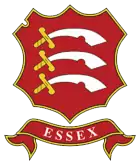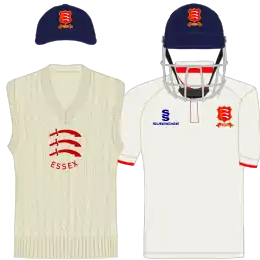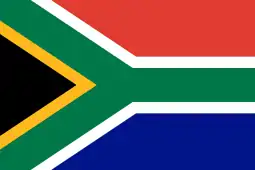Essex County Cricket Club
Essex County Cricket Club is one of eighteen first-class county clubs within the domestic cricket structure of England and Wales. It represents the historic county of Essex. Founded in 1876, the club had minor county status until 1894 when it was promoted to first-class status pending its entry into the County Championship in 1895, since then the team has played in every top-level domestic cricket competition in England. Essex currently play all their home games at the County Cricket Ground, Chelmsford. The club has formerly used other venues throughout the county including Lower Castle Park in Colchester, Valentines Park in Ilford, Leyton Cricket Ground, the Gidea Park Sports Ground in Romford, and Garon Park and Southchurch Park, both in Southend. Its limited overs team is called the Essex Eagles, whose team colours are all-blue.
 | ||||
| One Day name | Essex Eagles | |||
|---|---|---|---|---|
| Personnel | ||||
| Captain | Tom Westley | |||
| Coach | Anthony McGrath | |||
| Team information | ||||
| Founded | 1876 | |||
| Home ground | County Ground, Chelmsford | |||
| Capacity | 5,500 | |||
| History | ||||
| First-class debut | Leicestershire in 1894 at Leyton | |||
| Championship wins | 8 | |||
| Pro40 wins | 5 | |||
| FP Trophy wins | 3 | |||
| Twenty20 Cup wins | 1 | |||
| B&H Cup wins | 2 | |||
| Bob Willis Trophy wins | 1 | |||
| Official website | EssexCricket | |||
| ||||

Honours
First XI honours
- County Championship (8) – 1979, 1983, 1984, 1986, 1991, 1992, 2017, 2019
- Division Two (2) – 2002, 2016
- Sunday/Pro 40 League (5) – 1981, 1984, 1985, 2005, 2006
- Division Two (1) – 2008
- Refuge Assurance Cup (1) - 1989
- Gillette/NatWest/C&G/Friends Provident Trophy (3) – 1985, 1997, 2008
- Twenty20 Cup (1) - 2019
- Benson & Hedges Cup (2) – 1979, 1998
- Bob Willis Trophy (1) – 2020
Second XI honours
- Second XI Championship (1) – 1973; shared (0) -
- Second XI Trophy (0) –
- Minor Counties Championship (0) – ; shared (0) -
Earliest cricket in Essex
It is almost certain that cricket reached Essex by the 16th century and that it developed during the 17th century with inter-parish matches being played. The first definite mention of cricket in connection with the county is a highly controversial match in 1724 between Chingford and Mr Edwin Stead's XI, which is recorded in The Dawn of Cricket by H. T. Waghorn. The venue is unknown but, if it was at Chingford, it is also the earliest reference to cricket being played in Essex as well as by an Essex team. The game echoed an earlier one in 1718 as the Chingford team refused to play to a finish when Mr Stead's team had the advantage. A court case followed and, as in 1718, it was ordered to be played out presumably so that all wagers could be fulfilled. We know that Lord Chief Justice Pratt presided over the case and that he ordered them to play it out on Dartford Brent, though it is not known if this was the original venue. The game was completed in 1726.
The earliest reference to a team called Essex is in July 1732 when a combined Essex & Herts team played against the London Cricket Club. In July 1737, there was London v Essex at the Artillery Ground, London winning by 45 runs. In a return game at Ilford on 1 August 1737, Essex won by 7 runs. References are then occasional until 1785 when the Hornchurch Cricket Club became prominent. This club had a strong team that was representative of Essex as a county. However, the sources differed among themselves re whether the team should be called Essex or Hornchurch. But there is no doubt that Essex was a First-Class county from 1785 until 1794, after which the county strangely and abruptly disappeared from the records for a long time.
Club history
Essex CCC were formed on 14 January 1876 at a meeting in the Shire Hall, Chelmsford. The new club did not become First-Class until 1894, playing its inaugural first-class match on 14, 15 & 16 May 1894 against Leicestershire CCC at Leyton. It was the initial First-Class match played by either club, and Essex failed to win a match against any other county.[1] In 1895, both of these clubs and Warwickshire CCC joined the County Championship. In the club's first championship match, of their first championship season, James Burns scored 114 against Warwickshire at Edgbaston and this was the first century for Essex in the First-Class cricket. G.F. Higgins scored the second championship century for Essex in the same match putting on 205 with Burns for the fourth wicket. The club made an extraordinary score of 692 against Somerset with the rarely available veteran Bunny Lucas scoring 145, but the most notable feat was by Walter Mead who took 17–119 against Hampshire CCC at Southampton.

Essex improved rapidly from 1895, so that by 1897 they were in the running for the Championship, only losing it when Surrey beat them at Leyton.[2] They fell off after this despite beating a fine Australian team on a dubious pitch in 1899, never finishing higher than sixth between 1899 and 1932.[3] Their batting on Leyton's excellent pitches was generally good with the "Essex Twins" of Perrin and McGahey and the sound and skilful Jack Russell, but the bowling depended too much on Mead, Buckenham and later Douglas and when available Louden.
With the decline of these players, Essex fell to some of their lowest levels ever during the late 1920s. Their bowlers conceded over 40 runs a wicket in 1928 – about the highest ever with uncovered pitches. The emergence of Jack O'Connor, Stan Nichols and when available, the amateur fast bowlers Ken Farnes and Hopper Read, though, made Essex during the 1930s a dangerous if inconsistent side. They finished as high as fourth in 1933, and owing to their pace bowling maintained almost as high a standard up to the outbreak of war. The batting, however, tended to depend too much upon O'Connor and a number of amateurs who were rarely available, and Essex lost too many games to break the North's stronghold on the Championship.
After World War II Essex fell off, taking their first wooden spoon in 1950. During this period it was left to Trevor Bailey to do all the pace bowling, and he was often unavailable due to Test calls, whilst spinner Peter Smith was frequently overbowled until he retired in 1951 – thus a strong batting line-up led by Bailey and Doug Insole could seldom win games. Not until 1957 did Essex come back into the top half of the table, but Bailey and Barry Knight never had support of sufficient class to permit them to reach the top of the table, even when Robin Hobbs became England's last successful leg-spinner late in the 1960s.
In the 1970s, with overseas players now permitted, Essex were able to gradually strengthen their team to achieve much more than they ever had before. This decade saw the advent of Graham Gooch, one of England's finest opening batsmen, even though he began his Test career with a pair against Australia in 1975. He didn't return to the England team until 1978, but after a slow start began to assert his dominance over Test bowlers as he had on the county scene. Dedicated to training, he forced his burly physique through a tough regime to prolong his career long after some of his contemporaries had retired.
Along with Gooch, county captain and England batsman Keith Fletcher built a powerful eleven in the late 1970s that dominated domestic cricket from 1979 to 1992, when Essex won six of thirteen County Championship titles. The bowling in the first half of this period was borne by tireless left arm seamer John Lever and spinner and prankster Ray East. The South African Ken McEwan and Fletcher were the best batsmen after Gooch. As Lever declined, England all rounder Derek Pringle and fast bowler Neil Foster took over, whilst John Childs crossed from Gloucestershire to take over as the chief spinner.
In the 1990s, Essex had more internationals, including Nasser Hussain, who captained England in several series. Bowlers Mark Ilott and Peter Such earned caps, as well as wicket keeper James Foster. Ashley Cowan toured the West Indies in 1997/98 without playing an international match. Essex were also able to sign England fast bowlers Darren Gough and Alex Tudor, after they left Yorkshire and Surrey respectively.
Led by all-rounder Ronnie Irani Essex won the National League Division 1 title in 2005, their first major title in eight years.
In 2006, Essex successfully defended their National League title in the newly rebranded Pro40 format by the narrowest of margins, having tied for the title on points. The club missed out on promotion in the County Championship only on the last day of the season, losing to Leicestershire while their rivals Worcestershire beat Northamptonshire. In that season's Twenty20 Cup Essex beat Yorkshire to reach the semi-finals at Trent Bridge, where they were beaten by eventual tournament winners Leicestershire. Essex also had Twenty20 success in the first floodlit Twenty20 Tournament, held between the four teams with permanent floodlights, in a series of 2 legged matches. Essex beat Derbyshire 1–0, after the first leg was washed out, and they won the second leg convincingly.
Essex was promoted back to Division one for the 2010 season.[4] Essex won the County Championship in 2017[5] and 2019[6]
Home grounds
The club currently plays all its home games at Chelmsford – Colchester's cricket festival has been suspended since the 2017 season.[7]
Players
Current squad
- No. denotes the player's squad number, as worn on the back of their shirt.
 denotes players with international caps.
denotes players with international caps.- * denotes a player who has been awarded a county cap.
| No. | Name | Nat | Birth date | Batting Style | Bowling Style | Notes |
|---|---|---|---|---|---|---|
| Batsmen | ||||||
| 6 | Varun Chopra* | 21 June 1987 | Right-handed | Right-arm off break | ||
| 10 | Nick Browne* | 24 March 1991 | Left-handed | Right-arm leg break | ||
| 21 | Tom Westley* | 13 March 1989 | Right-handed | Right-arm off break | Club captain | |
| 23 | Feroze Khushi | 23 June 1999 | Right-handed | Right-arm medium | ||
| 26 | Sir Alastair Cook* | 25 December 1984 | Left-handed | Right-arm medium | ||
| 27 | Ryan ten Doeschate* | 30 June 1980 | Right-handed | Right-arm medium | ||
| 28 | Dan Lawrence* | 12 July 1997 | Right-handed | Right-arm leg break | ||
| 49 | Josh Rymell | 4 April 2001 | Right-handed | Right-arm medium | ||
| 89 | Cameron Delport | 12 May 1989 | Left-handed | Right-arm medium | UK Passport; T20 only | |
| All-rounders | ||||||
| 11 | Simon Harmer* | 10 February 1989 | Right-handed | Right-arm off break | Overseas player; T20 captain | |
| 22 | Paul Walter | 28 May 1994 | Left-handed | Left-arm fast-medium | ||
| Wicket-keepers | ||||||
| 9 | Will Buttleman | 20 April 2000 | Right-handed | — | ||
| 19 | Michael Pepper | 25 June 1998 | Right-handed | — | ||
| 31 | Adam Wheater* | 13 February 1990 | Right-handed | — | ||
| Bowlers | ||||||
| 14 | Aaron Beard | 15 October 1997 | Left-handed | Right-arm fast-medium | ||
| 16 | Sam Cook* | 4 August 1997 | Right-handed | Right-arm fast-medium | ||
| 24 | Aron Nijjar | 24 September 1994 | Left-handed | Slow left-arm orthodox | ||
| 29 | Shane Snater | 24 March 1996 | Right-handed | Right-arm fast-medium | ||
| 44 | Jamie Porter* | 25 May 1993 | Right-handed | Right-arm fast-medium | ||
| 64 | Peter Siddle | 25 November 1984 | Right-handed | Right-arm fast-medium | Overseas player | |
| 65 | Ben Allison | 18 December 1999 | Right-handed | Right-arm fast-medium | ||
| 77 | Jack Plom | 27 August 1999 | Right-handed | Right-arm fast-medium | ||
| 94 | Matt Quinn | 28 February 1993 | Right-handed | Right-arm fast-medium | UK Passport | |
Essex players with international caps
Essex county cricketers who have during their career also represented their national team in Test cricket, One Day International cricket or Twenty20 International cricket.
England
 Ronnie Irani
Ronnie Irani Graham Gooch
Graham Gooch Keith Fletcher
Keith Fletcher Jack Russell
Jack Russell Stan Nichols
Stan Nichols Ravi Bopara
Ravi Bopara Nasser Hussain
Nasser Hussain Alastair Cook
Alastair Cook Barry Knight
Barry Knight James Foster
James Foster Neil Foster
Neil Foster Nick Knight
Nick Knight Darren Gough
Darren Gough Paul Grayson
Paul Grayson Adam Hollioake
Adam Hollioake Mark Ilott
Mark Ilott Alex Tudor
Alex Tudor Jason Gallian
Jason Gallian John Lever
John Lever Walter Mead
Walter Mead Claude Buckenham
Claude Buckenham Jack O'Connor
Jack O'Connor Johnny Douglas
Johnny Douglas Frederick Fane
Frederick Fane Charlie McGahey
Charlie McGahey Paul Gibb
Paul Gibb Mike Denness
Mike Denness Aftab Habib
Aftab Habib John Stephenson
John Stephenson Jim Laker
Jim Laker Derek Pringle
Derek Pringle Martin Saggers
Martin Saggers Peter Such
Peter Such Owais Shah
Owais Shah Sajid Mahmood
Sajid Mahmood Reece Topley
Reece Topley Monty Panesar
Monty Panesar Tymal Mills
Tymal Mills Trevor Bailey
Trevor Bailey John Childs
John Childs Doug Insole
Doug Insole Peter Smith
Peter Smith Ken Farnes
Ken Farnes Neil Williams
Neil Williams Sailor Young
Sailor Young Hopper Read
Hopper Read Tom Westley
Tom Westley Dan Lawrence
Dan Lawrence
India
Bangladesh
Australia
.svg.png.webp) Mark Waugh
Mark Waugh.svg.png.webp) Andy Bichel
Andy Bichel.svg.png.webp) Bruce Francis
Bruce Francis.svg.png.webp) Michael Kasprowicz
Michael Kasprowicz.svg.png.webp) Stuart Law
Stuart Law.svg.png.webp) Allan Border
Allan Border.svg.png.webp) Merv Hughes
Merv Hughes.svg.png.webp) Bryce McGain
Bryce McGain.svg.png.webp) Robert Quiney
Robert Quiney.svg.png.webp) Shaun Tait
Shaun Tait.svg.png.webp) Peter Siddle
Peter Siddle.svg.png.webp) Adam Zampa
Adam Zampa
Pakistan
Netherlands
Zimbabwe
South Africa
 Hashim Amla
Hashim Amla Simon Harmer
Simon Harmer Lee Irvine
Lee Irvine Dale Steyn
Dale Steyn André Nel
André Nel Lonwabo Tsotsobe
Lonwabo Tsotsobe Alviro Petersen
Alviro Petersen Charl Willoughby
Charl Willoughby
West Indies
New Zealand
Records
|
Most first-class runs for Essex
|
Most first-class wickets for Essex
|
References
- Pardon, Sydney H.; John Wisden's Cricketers' Almanac; Thirty-Second Edition (1895); pp. 205–207
- Pardon, Sydney H.; John Wisden's Cricketers’ Almanac; Thirty-Fifth Edition (1898); pp. 45 and 56
- ^ Wynne-Thomas, Peter; The Rigby A-Z of Cricket Records; pp. 55–58 ISBN 072701868X
- "Essex 'patient' on player search". BBC Sport. 12 November 2009. Retrieved 6 December 2019.
- "County Championship Division One Table - 2017". ESPN cricinfo. ESPN. Retrieved 6 December 2019.
- "County Championship Division One Table - 2019". ESPN cricinfo. ESPN. Retrieved 6 December 2019.
- Jennings, Ryan (29 November 2018). "Colchester Cricket Festival suspended again next season". www.gazette-news.co.uk. Archived from the original on 8 February 2018. Retrieved 7 February 2018.
- "The Home of CricketArchive". Cricketarchive.com. Archived from the original on 3 March 2016. Retrieved 4 May 2013.
- "The Home of CricketArchive". Cricketarchive.com. Archived from the original on 3 March 2016. Retrieved 4 May 2013.
Further reading
- H. S. Altham, A History of Cricket, Volume 1 (to 1914), George Allen & Unwin, 1962
- Derek Birley, A Social History of English Cricket, Aurum, 1999
- Rowland Bowen, Cricket: A History of its Growth and Development, Eyre & Spottiswoode, 1970
- H. T. Waghorn, The Dawn of Cricket, Electric Press, 1906
- Roy Webber, The Playfair Book of Cricket Records, Playfair Books, 1951
- Playfair Cricket Annual – various editions
- Wisden Cricketers' Almanack – various editions
- Nasser Hussain Playing With Fire, Penguin 2005
